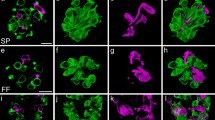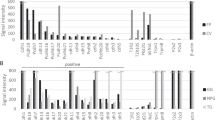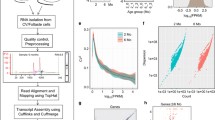Abstract
Developmental changes in the distribution pattern of taste buds in newborn mouse have not been previously elucidated, and little work has been done to examine the postnatal alteration of the expression of α-gustducin in the mouse taste buds. In the present paper, we delineated the development and frequency distribution of the taste buds as well as the immunohistochemical expression of α-gustducin, a G protein closely related to the transduction of taste stimuli in the fungiform papilla from the birthday till the age of week 9. At birth, more than 45 taste buds (with or without pores) were observed on the fungiform papilla, then the number of mature taste buds increased rapidly, and resulted in 66% (80.2 ± 0.6 of 122.2 ± 1.3) of fungiform papilla taste buds containing taste pores at week 3. By age the total counts of pored taste buds continuously increased and their morphological features became quite discernible. They became ellipse in shape, characterized by distinct pores. Quantitative analysis of α-gustducin expression at different postnatal ages revealed a significant increase in the number of immunolabeled taste buds and α-gustducin-positive cells in single taste buds from week 1 to 7, by week 7, the number reached the value found in adults (99.3 ± 0.9 and 8.3 ± 0.3, respectively). These results indicated that taste buds within fungiform papilla play an important role in the detection of nutrients in the postnatal mouse.




Similar content being viewed by others
References
Boughter JD, Pumplin DW, Yu C, Christy RC, Smith DV (1997) Differential expression of alpha-gustducin in taste bud populations of the rat and hamster. J Neurosci 17:2852–2858
Clapp TR, Stone LM, Margolskee RF, Kinnamon SC (2001) Immunocytochemical evidence for co-expression of type III IP3 receptor with signaling components of bitter taste transduction. BMC Neuroscience 2:6. http://www.biomedcentral.com/1471-2202/2/6 (doi: 10.1186/1471-2202-2-6)
Farbman AI (1965) Electron microscope study of the developing taste bud in rat fungiform papilla. Dev Biol 11:110–135
Ganchow JR, Steiner JE, Canetto S (1986) Behavioral displays to gustatory stimuli in newborn rat pups. Dev Psychobiol 19:163–174
Harada S, Yamaguchi K, Kanemaru N, Kasahara Y (2000) Maturation of taste buds on the soft palate of the postnatal rat. Physiol Behav 68:333–339
Hendricks SJ, Brunjes PC, Hill DL (2004) Taste bud cell dynamics during normal and sodium-restricted development. J Comp Neurol 472:173–182
Hosley MA, Oakley B (1987) Postnatal development of the vallate papilla and taste buds in rats. Anat Rec 218:216–222
Mbiene JP, Farbman AI (1993) Evidence for stimulus access to taste cells and nerves during development: an electron microscopic study. Microsc Res Tech 26:94–105
McLaughin SK, McKinnon PJ, Margolskee RF (1992) Gustducin is a taste-cell-specific G protein close related to the transducins. Nature 357:563–569
Mistretta CM (1972) Topographical and histological study of the developing rat tongue, palate and taste buds. In: Bosma JF (ed) Third symposium on oral sensation and perception. Thomas, Springfield, pp 163–187
Pérez CA, Margolskee RF, Kinnamon SC, Ogura T (2003) Making sense with TRP channels: store-operated calcium entry and the ion channel TRPM5 in taste receptor cells. Cell Calcium 33:541–549
Sbarbati A, Crescimanno C, Bernardi P, Osculati F (1999) Alpha-gustducin-immunoreactive solitary chemosensory cells in the developing chemoreceptorial epithelium of the rat vallate papilla. Chem Senses 24:469–472
Shen T, Kaya N, Zhao FL, Lu SG, Cao Y, Herness S (2005) Co-expression patterns of the neuropeptides vasoactive intesyinal peptide and cholecystokinin with the transducyion molecules alpha-gustducin and tir1 in rat taste receptor cells. Neuroscience 130:229–238
Steiner JE (1973) The gustofacial response: observations on normal and anencephalic newborn infants. In: Bosma JF (ed) Fourth symposium on oral sensation and perception US Department of D. H. E. W., Bethesda, pp 254–278
Steiner JE (1987) What the neonate can tell us about umami. In: Kawamura Y, Kare MR (eds) Umami: a basic taste. Marcel Dekker, New York, pp 97–123
Takami S, Getchell TV, McLaughlin SK, Margolskee RF, Getchell ML (1994) Human taste cells express the G protein alpha-gustducin and neuron-specific enolase. Brain Res Mol Brain Res 22:193–203
Yang R, Tabata S, Crowley HH, Margolskee RF, Kinnamon JC (2000) Ultrastructural localization of gustducin immunoreactivity in microvilli of type II taste cells in the rat. J Comp Neurol 425:139–151
Author information
Authors and Affiliations
Corresponding author
Additional information
Grant sponsor: National Natural Science Foundation of China; Grant number: 30060025.
Rights and permissions
About this article
Cite this article
Zhang, GH., Deng, SP., Li, LL. et al. Developmental change of α-gustducin expression in the mouse fungiform papilla. Anat Embryol 211, 625–630 (2006). https://doi.org/10.1007/s00429-006-0112-2
Accepted:
Published:
Issue Date:
DOI: https://doi.org/10.1007/s00429-006-0112-2




